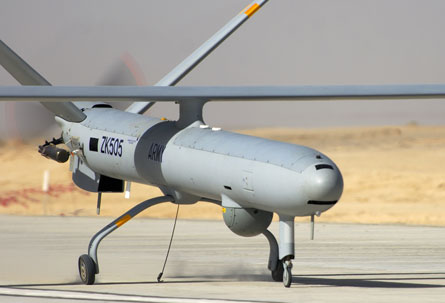The British Army's Elbit Systems Hermes 450 deployment in Afghanistan and Iraq has reached a total of 7,000 flying hours, and lessons learned are being rolled into the UK's Watchkeeper tactical unmanned air vehicle programme.
Deployed to Iraq in July 2007 and Afghanistan a month later, the UK Ministry of Defence's prime contractor for the interim Hermes service, Thales UK, has provided in-field service representatives to support the army's 32 Regt, Royal Artillery during intelligence, surveillance, target acquisition and reconnaissance operations.
 |
|---|
© Thales UK |
Using the UAV's electro-optical/infrared payload, ISTAR missions have included identifying Taliban repeater stations, following insurgents from a contact back to their hideout and flying low over enemy combatants, causing them to retreat.
Hermes air vehicles have flown 3,000h in Iraq and 4,000h in Afghanistan since last year, with the army saying there have been no crashes or incidents.
"A year ago we couldn't [track insurgents]," says Lt Col Neil McRobb, adding: "If I have two Hermes and two more for back-up I have enough [for the ISTAR role]."
Speaking at the 23rd Bristol International UAV Systems Conference in the UK on 7 April, he said: "We have learnt lessons, but there will be no fundamental change for Watchkeeper."
Human/machine interface changes for the UAV's ground-control equipment have been the main alterations suggested, with McRobb adding that the biggest problem encountered during operations has been an inability to react to changing weather conditions due to the operator's remote location from the vehicle.
 |
|---|
© Thales UK |
Human factors have been identified as the most likely cause of a UAV failure, due to a failure to adapt to the weather.
McRobb says the environments of Iraq and Afghanistan are also completely different. Overheating has not been a problem, despite a perception of the operational theatres being hot, while carburettor icing has been an issue for all the UAVs.
Radio frequency spectrum management has also been a factor, with Special Forces personnel declining to reveal what they are flying and when.
Other UAV systems used on operations by 32 Regt have included Lockheed Martin's Desert Hawk I, I+ and III, Mission Technologies' Buster and BAE Systems' Phoenix the last of which were retired from service last month.
Source: FlightGlobal.com























